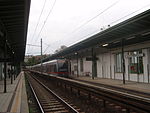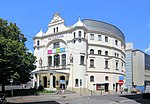St. Canisius's Church, Vienna
1903 establishments in Austria1903 in Austria20th-century Roman Catholic church buildings in AustriaAll pages needing cleanupRoman Catholic churches in Austria ... and 2 more
Roman Catholic churches in ViennaWikipedia introduction cleanup from September 2016

The St. Canisius's Church is a Roman Catholic parish church in the 9th District of Vienna, Alsergrund.
Excerpt from the Wikipedia article St. Canisius's Church, Vienna (License: CC BY-SA 3.0, Authors, Images).St. Canisius's Church, Vienna
Lustkandlgasse, Vienna KG Alsergrund (Alsergrund)
Geographical coordinates (GPS) Address Nearby Places Show on map
Geographical coordinates (GPS)
| Latitude | Longitude |
|---|---|
| N 48.2285 ° | E 16.3516 ° |
Address
Lustkandlgasse 37
1090 Vienna, KG Alsergrund (Alsergrund)
Austria
Open on Google Maps









